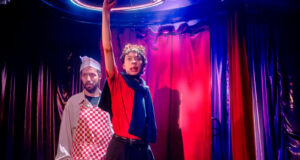Pros: Beautiful, swirling, powerful performances by all eleven dancers.
Cons: You’ll need to do your research to fully appreciate this production. An intellectually curious show stumbles over its own cleverness, but is mesmerising nonetheless.
Summary
Rating
Good
I’ll start with a confession: I went into this ballet knowing nothing about it, save that I always enjoy being at Sadler’s Wells, and that Shobana Jeyasingh’s production of La Bayadère was performed at the Royal Opera House two years ago to great acclaim.
It is, I now know, a classic ballet, a 19th century Orientalist fantasy about an Indian temple dancer – a bayadère – who loses first her lover and then her life to a jealous princess and her scheming father. The original is full of Victorian imaginings about India: sensual snake-like movements, harems, colourful exotic garments and opium-induced dreams. According to the programme, Shobana Jeyasingh Dance set out to offer audiences an alternative interpretation of the ballet. Shobana, a Londoner born in India, has long been fascinated by the ballet and the West’s Indian fantasies that abounded at the time of the ballet’s creation.
The performance starts with elaborate scene-setting, in which a young British-Indian man, surrounded by honking cars of Mumbai, is told the story of the bayadère through a series of Whatsapp messages from his brother, who was dragged to see the show the night before. In a somewhat clunky transition, the brother relates how powerfully he felt that he was part of the story – and all at once we are plunged from modern-day India into the bayadère’s world.
Here, the criticism of the original’s pseudo-ethnographic rendition becomes fuzzy, as the choreography makes use of the very Orientalist elements it sets out to question. There is an interesting subversion in the fact that the modern-day brother becomes a temple dancer himself, essentially turning into a sexual symbol, but beyond this the production ends in a bit of a muddle. The use of technology to render the blurry boundaries between old and new felt rather gimmicky, and distracted from the dancers’ beautiful performances.
Having now done my research, I can appreciate much more what Shobana Jeyasingh Dance set out to achieve. That said, it feels like some interesting intellectual mind-games should have given way to make for a tighter and more concise production.
Choreographer and Director: Shobana Jeyasingh
Composer: Gabriel Prokofiev
Set and Costume Designer: Tom Piper
Booking Information: This show has now finished its run.
 Everything Theatre Reviews, interviews and news for theatre lovers, London and beyond
Everything Theatre Reviews, interviews and news for theatre lovers, London and beyond



